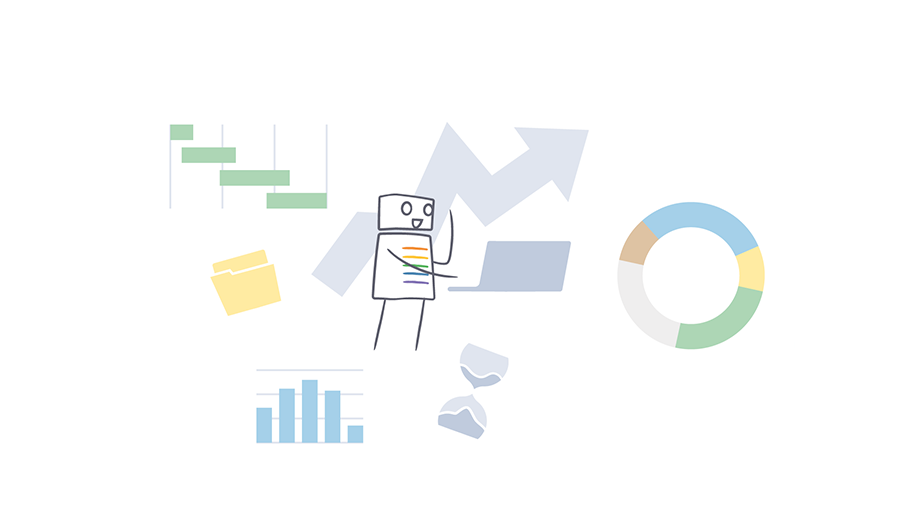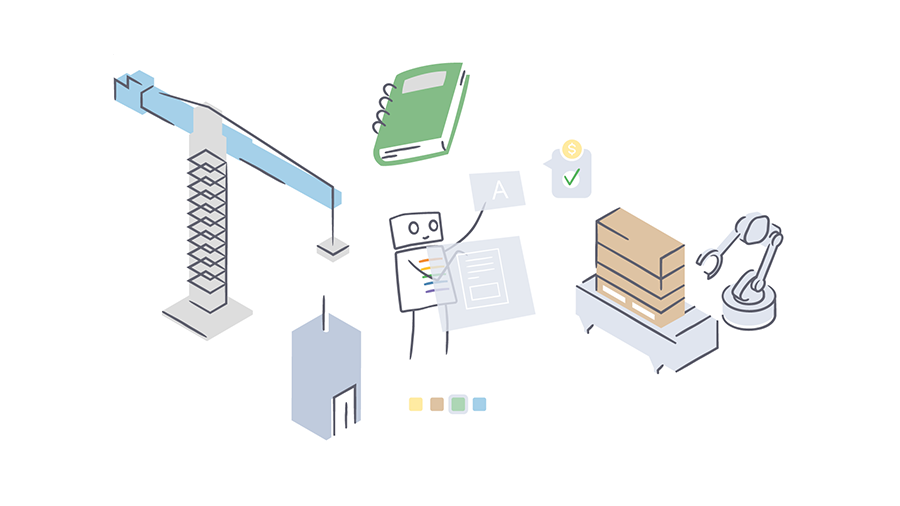
Business productivity: how to measure and improve it (part 1)

Let’s start from an observation that makes the topic seem "uncomfortable". The interest in knowing how to measure company productivity is not a twentieth-century control craze but a way to improve and guarantee company longevity and better conditions for all of those who participate in business life (an inefficient company can hardly improve the economic and working conditions of its employees).
The second observation is that company productivity should not be measured only in the production department where it is probably easier to do so. The challenge is to measure the productivity for those who not only produce objects but also their designs, source code, etc. We know, it seems blasphemous, but the company must know at what point is the design and whether there are criticalities that can be addressed. Yet all attempts to measure the productivity of a technical office have ended up plastering it and, after the initial enthusiasm, they have all been abandoned.
We too have tried many approaches to measure the productivity of our team that does not make pieces of products but, that does design and we think we have ALMOST found the square of the circle. In the "Part 2" of this story we will turn on the lights right on the technical office while in this "Part 1" we will provide the basic ingredients.
Are you already digital?
Without a doubt, for some time now you have been equipped with some computer system that helps you to speed up some daily tasks such as creating, searching and storing documents. Or a tool that helps you manage CAD data or orders.
Well, surely it is a necessary step to do not waste time and ride the wave of digital transformation but definitely not enough to get dizzying results in terms of reaching your potential.
In this article we will talk about some methods that can help you improve production efficiency but also (and above all) to measure it. Because improvements without data about them are worth little, they can be perceived as lucky or random strokes of the period and become difficult to replicate or scale.
What is business productivity?
Let’s take a step back and explain first what we mean by business productivity. Business productivity can be understood as an indicator of the efficiency with which the company, or its individual departments, generate goods or services with a certain number of resources within a specific time. The three key factors to measure productivity are: time, resources (both in terms of personnel, machinery and material) and the final product.
We can say that the more productive our work is, the more quality output our company will be able to produce, using less resources and time.
How is business productivity calculated?
Now that we have specified what is the business productivity we can see the different ways of calculating it.
KPI – Key Performance Indicator
When we talk about calculating productivity, or more generally, measuring any result we need to start from KPIs, the productivity indices. They are crucial in the process of strategic control and management. It’s okay to have the right insights but you can’t always rely on the sixth sense and that’s why data will be your best ally.
The question arises: what KPIs to monitor? How to monitor all data?
To collect data there are several systems that you can buy and that monitor for example: staff hours, machine work, lead time, worker productivity and much more.
The choice lies in the data that are most useful for achieving your goals.
L’OEE and Gantt diagram
For those involved in the production of any good, measure the OEE and have under the eye the diagram of Gantt is fundamental (in "Part 2" we will see that the last part is not always true).
The Overall Equipment Effectiveness calculates the total effectiveness of a plant. It is a measure influenced by productivity, availability and quality. It helps to give a complex and general measure of the health of the plant, of the production line and why not, of an order. It is an important indicator of Lean Production (a set of techniques and strategies that starts from the organizational philosophy aimed at reducing waste within the processes and starts from the assumption that every activity can be improved with "simplicity").
The Gantt Diagram allows you to understand if you can meet the delivery times, have an overview of the progress of the activities, know how to reorganize the shifts according to the results and much more. It is basically a tool to represent and graphically visualize the timing and progress of a project. It gives indications on the activities carried out by each resource and a vision of the work still to be done to reach the final goal.
5 ways to improve your business productivity
Now that we’ve talked about how you can measure business productivity and what indicators to keep an eye on, let’s look at how you could improve production efficiency.
We propose 5 practical ways to improve your production efficiency with a premise. Some are really simple to obtain, some will seem so far away that it seems impossible to you but in these parts the impossible word has remained out of the dictionary.
So:
1) Always estimate the time
Before leaving with any activity it is essential to give an estimate of the time you think it takes. You don’t have to imagine this measure by taking the best employee or the fastest machine and not even the weakest worker or the oldest machinery. You must always think about the average of what you have. If you cannot give an estimate then you have not yet broken the problem down into sub-problems. There are many ways to estimate: experience, past analysis, costing software, etc. Obviously this is strongly influenced by context. In the production field, the Processing Cycle always collects these estimates. If you produce standard items you will have an accurate estimate dictated by the past. If you make it special it gets complicated and someone in these cases makes software that can help.
2) Track the time
It is crucial to measure the time it actually takes to perform a particular task. This data cross-referenced with the context (alarms, anomalies, shifts, human resources, machinery...) allows to identify the time losses and to bring out the reasons that slow down the work. In order to do this it is necessary to acquire a tool that is able to give a complete vision of how the personnel and the means spend their time and improve in this way the efficiency.
3) Analise and improve business procedures
Having predetermined procedures to follow helps by far in speeding up decision-making processes and avoiding mistakes that would lead to unnecessary waste of time and important resources. The well-researched business processes turn out to be a lifebuoy when a thousand orders or unforeseen events arrive and you have to manage them all without causing trouble. Learn more about how to simplify business processes.
4) Reduce the use of paper
Let’s be clear, if in companies there is a lot of paper it is not because they are green and want to fight plastic. Paper is often a symptom of a digitization problem. If you point out on a sheet of paper that a tolerance is wrong, it is not said that this information gets to who put that indication. If you take the times on a sheet there must be someone else who then transforms them into data and inserts them into a computer system. So you two are doing the same job and the important information may come too late to who should correct the shot.
But it is not even said that a 4.0 machine that gives alarms, parts made and consumption solve those problems, if it does not dialogue with the rest of the company systems. The tools you choose must interact and cooperate with other systems. So make sure that the tools you buy are integrated or can be integrated with those you already have in the company.
5) Using Data must become a mantra
The data is gold nowadays, it is not by chance that we always read a thousand news and articles about it starting from scandals to important praise for the management of Big Data, so much so that perhaps you are now coming indigestion of these issues. But we tell you that a good analysis and understanding of your company’s data will be the basis for improvements. They allow us to analyze opportunities and criticalities, they can predict the production block, they show us if our investments are profitable, they help us understand how to reduce time and costs, what strategic decisions to make and much, much more. So we suggest that you equip yourself with a system that is capable of collecting and processing all the important data of your company, with efficiency, security and clarity.
How about the Artificial Intelligence?
In recent times the theme of AI has gone from being a fantasy for nerds to being a topic discussed in unsuspected chats whatsapp. The "fault" of this is largely due to ChatGPT which is the undisputed star of the web of this last period. Many of the most computer-resistant have been amazed and worried about the magical capabilities of a system that can respond to any topic much better than an overpaid consultant. And we confess that even those of us who are involved in AI were quite surprised.
No one (except Elon Musk) can, for now, imagine a humanoid robot to the "I Robot" that designs and produces without there being humans around. If this is still early, however, it is already possible to use AI to revolutionize the OEE of your company.
Around here we are working on this and our headquarters is the riot of Big Data, iot Systems (Internet of Things) and Neural Networks.
However, we must not forget that an AI system feeds on data and if there are no data, it will be impossible to activate it later.
Solutions to improve your productivity
We have seen in this introductory article what business productivity is, how it measures and what are some of the possible ways to improve it.
We refer you to "Part 2" that will arrive shortly. Of course, you can immediately contact your technology partner to find the right solution for you.
Mehr von Alexide
Are you ready for the Big Data era?
Data ManagementWhich product configurator to choose?
Product configuratorHaben Sie Fragen? Wir sind für Sie da.
Füllen Sie das Formular aus oder senden Sie uns eine E-Mail an info@solidrules.com. Wir werden uns mit Ihnen in Verbindung setzen und Ihnen alle Lösungen anbieten.









